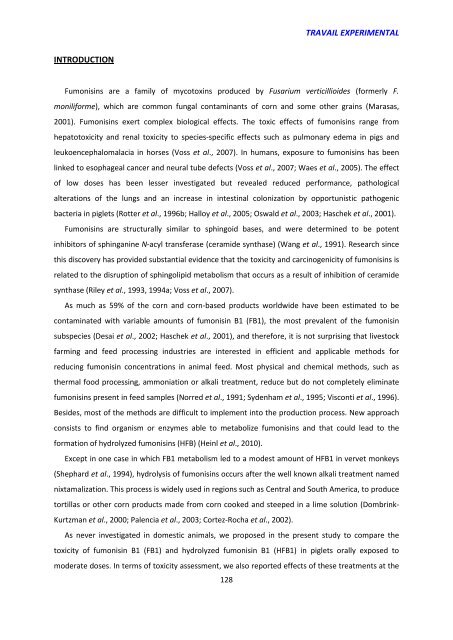Effet chez le porcelet d'une exposition à un régime co-contaminé en ...
Effet chez le porcelet d'une exposition à un régime co-contaminé en ...
Effet chez le porcelet d'une exposition à un régime co-contaminé en ...
Create successful ePaper yourself
Turn your PDF publications into a flip-book with our unique Google optimized e-Paper software.
TRAVAIL EXPERIMENTALINTRODUCTIONFumonisins are a family of my<strong>co</strong>toxins produced by Fusarium verticillioides (formerly F.moniliforme), which are <strong>co</strong>mmon f<strong>un</strong>gal <strong>co</strong>ntaminants of <strong>co</strong>rn and some other grains (Marasas,2001). Fumonisins exert <strong>co</strong>mp<strong>le</strong>x biological effects. The toxic effects of fumonisins range fromhepatotoxicity and r<strong>en</strong>al toxicity to species-specific effects such as pulmonary edema in pigs and<strong>le</strong>uko<strong>en</strong>cephalomalacia in horses (Voss et al., 2007). In humans, exposure to fumonisins has be<strong>en</strong>linked to esophageal cancer and neural tube defects (Voss et al., 2007; Waes et al., 2005). The effectof low doses has be<strong>en</strong> <strong>le</strong>sser investigated but revea<strong>le</strong>d reduced performance, pathologicalalterations of the l<strong>un</strong>gs and an increase in intestinal <strong>co</strong>lonization by opport<strong>un</strong>istic pathog<strong>en</strong>icbacteria in pig<strong>le</strong>ts (Rotter et al., 1996b; Halloy et al., 2005; Oswald et al., 2003; Haschek et al., 2001).Fumonisins are structurally similar to sphingoid bases, and were determined to be pot<strong>en</strong>tinhibitors of sphinganine N-acyl transferase (ceramide synthase) (Wang et al., 1991). Research sincethis dis<strong>co</strong>very has provided substantial evid<strong>en</strong>ce that the toxicity and carcinog<strong>en</strong>icity of fumonisins isrelated to the disruption of sphingolipid metabolism that occurs as a result of inhibition of ceramidesynthase (Ri<strong>le</strong>y et al., 1993, 1994a; Voss et al., 2007).As much as 59% of the <strong>co</strong>rn and <strong>co</strong>rn-based products worldwide have be<strong>en</strong> estimated to be<strong>co</strong>ntaminated with variab<strong>le</strong> amo<strong>un</strong>ts of fumonisin B1 (FB1), the most preva<strong>le</strong>nt of the fumonisinsubspecies (Desai et al., 2002; Haschek et al., 2001), and therefore, it is not surprising that livestockfarming and feed processing industries are interested in effici<strong>en</strong>t and applicab<strong>le</strong> methods forreducing fumonisin <strong>co</strong>nc<strong>en</strong>trations in animal feed. Most physical and chemical methods, such asthermal food processing, ammoniation or alkali treatm<strong>en</strong>t, reduce but do not <strong>co</strong>mp<strong>le</strong>tely eliminatefumonisins pres<strong>en</strong>t in feed samp<strong>le</strong>s (Norred et al., 1991; Syd<strong>en</strong>ham et al., 1995; Vis<strong>co</strong>nti et al., 1996).Besides, most of the methods are difficult to imp<strong>le</strong>m<strong>en</strong>t into the production process. New approach<strong>co</strong>nsists to find organism or <strong>en</strong>zymes ab<strong>le</strong> to metabolize fumonisins and that <strong>co</strong>uld <strong>le</strong>ad to theformation of hydrolyzed fumonisins (HFB) (Heinl et al., 2010).Except in one case in which FB1 metabolism <strong>le</strong>d to a modest amo<strong>un</strong>t of HFB1 in vervet monkeys(Shephard et al., 1994), hydrolysis of fumonisins occurs after the well known alkali treatm<strong>en</strong>t namednixtamalization. This process is widely used in regions such as C<strong>en</strong>tral and South America, to producetortillas or other <strong>co</strong>rn products made from <strong>co</strong>rn <strong>co</strong>oked and steeped in a lime solution (Dombrink-Kurtzman et al., 2000; Pa<strong>le</strong>ncia et al., 2003; Cortez-Rocha et al., 2002).As never investigated in domestic animals, we proposed in the pres<strong>en</strong>t study to <strong>co</strong>mpare thetoxicity of fumonisin B1 (FB1) and hydrolyzed fumonisin B1 (HFB1) in pig<strong>le</strong>ts orally exposed tomoderate doses. In terms of toxicity assessm<strong>en</strong>t, we also reported effects of these treatm<strong>en</strong>ts at the128

















